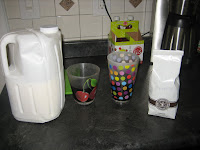A good gut feeling about coffee---and how to treat difficult intestinal infections
It’s hard
not to go down a rabbit hole if you google ‘fecal transplant.’
There’s so
much to explore—so many questions to answer. Where does the ‘good’ poop come
from? (Other people with healthy microbiomes.) How is it stored? (Different
ways—but it should be fresh upon transfer.) How is it transplanted? (Note:
Although fecal transplants are generally performed in clinical settings via
enema, colonoscopy, or other methods, there’s a burgeoning DIY community.)
Fecal
transplant, also known as fecal microbiota transplant (FMT), is intended to
reinvigorate the body’s microbiome---the community of thousands of different
types of bacteria that reside in the gut.
It’s true: Good health
starts in the gut. In fact, the body’s microbiome is the epicenter of our
immune system and implicated in everything from obesity, to chronic diseases, to
severe gastrointestinal distress and illnesses, to mental illness. Metaphorically
speaking, it’s a question of the balance between the good and the
bad---bacteria that is.
The goal of
an FMT is to improve the bacterial profile of an individual’s microbiome by
transferring healthy bacteria from a person with a healthy biome. During an FMT, more than one thousand bacteria are transferred (by comparison, there are about 30 different bacteria in top-brand
probiotics).
The reason
that FMT is becoming a household acronym is because it has proven helpful in
beating the most persistent, painful and deadly cases of Clostridium Difficile (C diff), a 'bad' bacteria in the gut that causes inflammation and illness. .
C diff cases
have been increasing, and the cases tend to be more severe than previously. CDC statistics peg
the total number of cases at roughly 500,000 per year, with roughly 15,000 deaths as a result.
While C diff is highly infectious and can be transferred simply by touching an
infected surface, the real problem is that taking antibiotics can decimate the
bacteria that could fight C diff and keep everything in balance, leading to an
overabundance of C diff---and all the symptoms that come with it, including
constant diarrhea, fever, gastrointestinal pain and profound fatigue.
C diff has
replaced MRSA as the most common hospital-acquired infection, so numerous
precautions should be taken in hospital settings. But even when there is no
imminent threat, it helps to know that things like taking probiotics and
drinking coffee can improve the overall profile of your microbiome.
In a study that
was published in the International Journal of Microbiology in 2009, researchers
found that individuals who drank 3 cups of coffee per day over a 3-week period,
had an increase in the metabolic activity in their microbiome, with an
increased presence of Bifido Bacterium species---good bacteria. Bifido bacteria
coat the lining of the intestines, stimulate the immune system and combat C
diff.
When it
comes to being healthy, every little bit helps. So a cup of coffee and a few
more Bifido Bacterium swimming around your microbiome are good things.
If you’re
interested you can learn more about Clostridium difficile here:




Comments